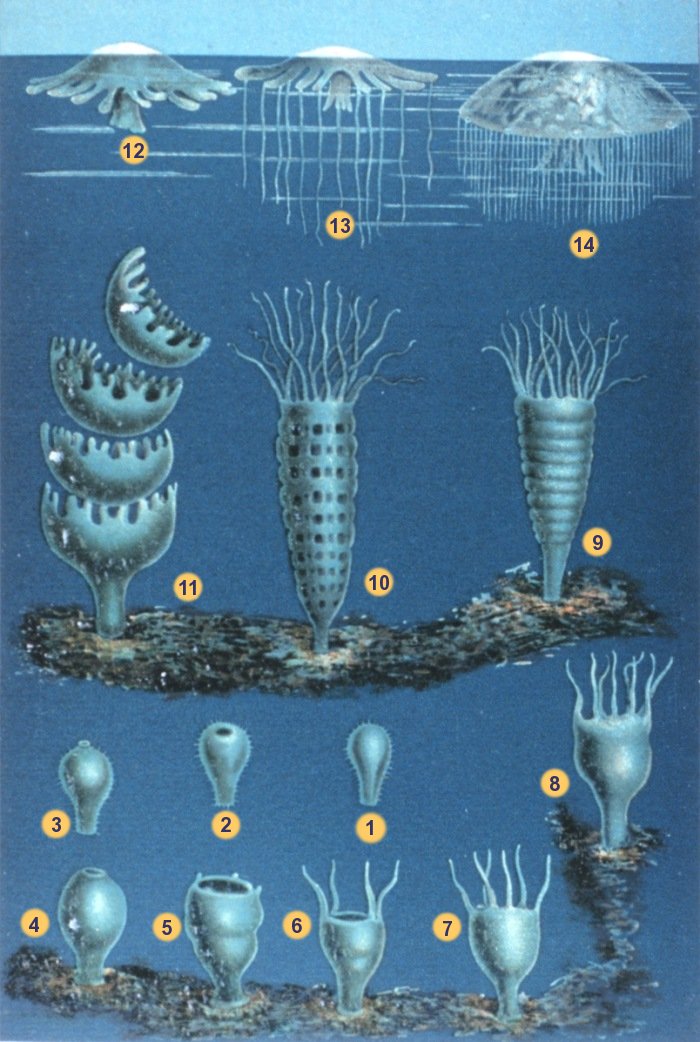
by Erik Lovestrand | May 29, 2015
![Life Stages of the True Jellyfish: Photo: By Matthias Jacob Schleiden (1804-1881) [Public domain], via Wikimedia Commons](https://nwdistrict.ifas.ufl.edu/nat/files/2015/05/Schleiden-meduse-2-202x300.jpg)
Life Stages of the True Jellyfish: Photo: By Matthias Jacob Schleiden (1804-1881) [Public domain], via Wikimedia Commons
“Ouch, something just stung me.” This is a common phrase to hear someone say (I’ve heard myself say it) while enjoying the otherwise soothing waters along our beautiful Gulf Coast. We host an amazing variety of marine organisms that possess the ability to sting when contacted. I’m referring to organisms in the phylum Cnidaria (pronounced “ni-dair-ee-ah”), which includes about 10,000 species that have been identified. There is general agreement on the classification of five different classes of cnidarians, all of which have stinging cells, but most of which are not dangerous to humans. These include Class Anthozoa (anemones and corals), Class Cubozoa (box jellyfish), Class Scyphozoa (true jellyfish), Class Staurozoa (stalked jellyfish) and Class Hydrozoa (hydroids i.e. Portuguese man o’ war). I’m always intrigued by the origin of scientific names so here is a slight tangent for you on the group names (Cnides: from the greek meaning nettle)(Antho: flower-like; Cubo: cube-shaped; Scypho: cup-shaped; Hydros: sea serpent; Stauro: cross-shaped). The term “zoa,” of course, refers to animals.
Most of the time you are stung in our local waters it involves the classes Hydrozoa or Scyphozoa. The Hydrozoans are a complex group of organisms but most species go through two distinct stages during their life cycle. The hydroid stage takes the form of a polyp which is composed of a stalk and tentacles at the end. Polyps can be single but are often colonial, connected by tube-like structures. Most polyps are specialized for feeding but others are used to reproduce. Reproductive polyps lack tentacles but have many buds which form the medusa stage of the organism for reproduction purposes. Medusae of the hydroids are similar in design but typically smaller than the medusae of the true jellyfish. Some hydroids also have specialized defensive polyps with numerous stinging cells and one species even has a specialized polyp that develops into a large balloon-like float that the others attach to (the man o’ war). There is one specific type of hydroid in our area that closely resembles a piece of branching brown algae, such as Sargassum. The polyps are scattered along the branches and when brushed against they fire their nematocysts (stinging cells) producing a painful sting. The burning sensation can last for several minutes and you would have sworn the only thing around you was a harmless piece of drift algae.
The true jellyfish, of Class Scyphozoa, also go through a polyp and medusa stage. The polyps of this class are typically single and settle to the bottom as larvae and attach themselves. Over time the polyps mature and produce other polyps by budding, or bud medusae off their upper surface. These jellyfish medusae are microscopic at this stage and many take years to reach maturity, complete with a cup-shaped (scypho= cup shaped) bell and tentacles hanging beneath.
The subsequent lives of these translucent marine creatures is no less intriguing than the processes involved in their development. Check out this website from the Smithsonian for more great information. The next time you feel the burn of a host of nematocysts injecting you with their potent venom, I dare you to stop for just a second to be amazed by the fascinating creature that you have just met. If you can pull this off you are well on your way to becoming the quintessential nature nut! Click here for helpful information if you are stung.
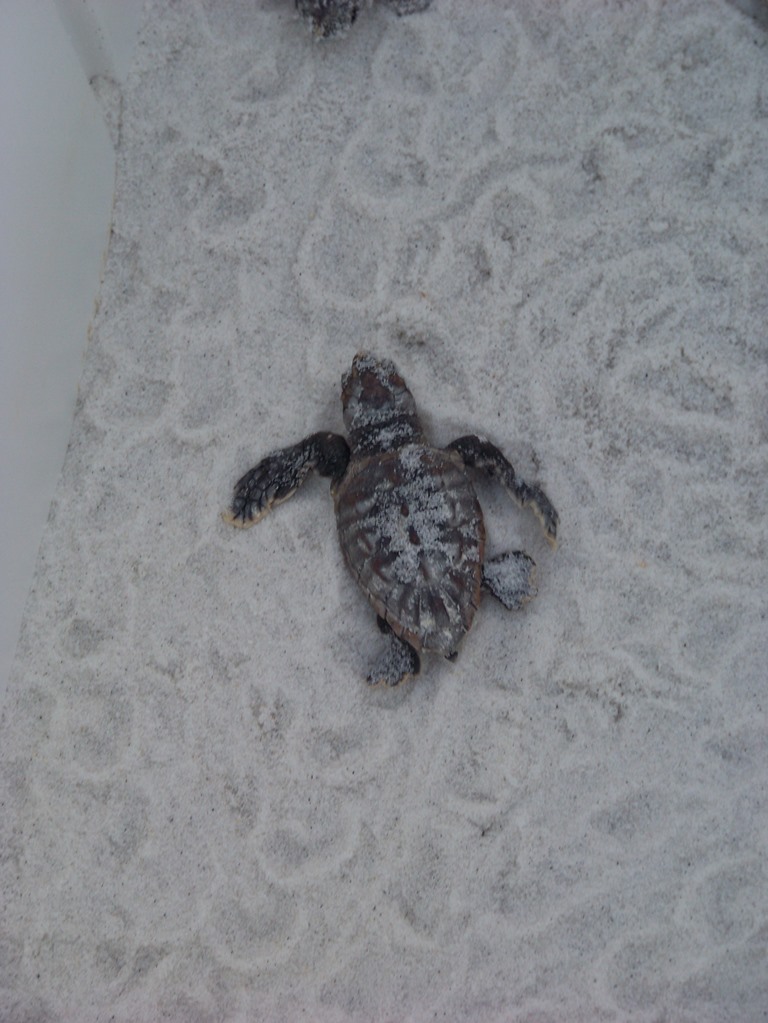
by Rick O'Connor | May 10, 2015
It is May and this is the official beginning of the sea turtle nesting season. These ancient creatures have followed this nesting cycle for centuries traveling the open ocean, feeding and resting on reefs, then returning to shore in the spring and summer to breed and lay their eggs on beaches and barrier islands. What is neat is that Dr. Archie Carr discovered they return to the same beaches near where they were born. So those visiting our beaches are in a sense, “our” turtles. Another interesting fact about panhandle sea turtles is that a significant number of male turtles are produced here. Gender in most turtles is determined by the temperature of the egg during incubation in the sand; colder temperatures producing males. Since the panhandle has cooler temperatures than the lower peninsula of Florida, we produce the majority of the males for our populations. This is also why we have fewer nests than south Florida, since it is the females who return to shore.
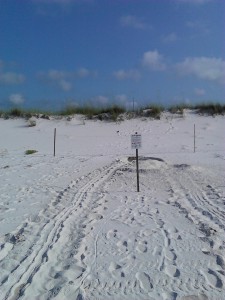
Tracks left by a nesting Green Sea Turtle. Courtesy of Gulf Islands National Seashore.
However, in the last 50 years more and more people have moved to the beaches and barrier islands of the panhandle and the sea turtles have run into problems continuing their ancient cycle. Four of the five species of sea turtles in the Gulf of Mexico are currently listed as endangered; the loggerhead is listed as a threatened species. Though they have issues with natural predators much of their trouble is due to human activities. HERE ARE FIVE THINGS YOU CAN DO TO HELP SEA TURTLE NESTING THIS SEASON.
- Offshore, more and more turtles are being struck by boats. These are air breathing reptiles and need to surface. Unfortunately nesting season is also during the height of fishing and diving season. Many boaters must follow no wake zones to reach open waters and want to open up the throttle when they do. As with manatees in our rivers we ask that you keep a lookout for the surfacing heads as you are heading to and from your destination.
- Both offshore and inshore sea turtles are encountering more plastics in the marine environment. Turtles become entangled in discarded fishing line and actually consume many forms of plastic debris drifting in the water column. One loggerhead found on Dauphin Island had 11 pounds of plastic lodged in its esophagus, which obviously kept it from feeding properly. When you go boating please develop some method of storing plastics and fishing line until you reach shore. Once you return to the boat ramp please use the fishing line recycle bins to discard your fishing line. Fishing line placed in these are recycled into new fishing line. If there is not a fishing line recycle bin at your boat ramp contact your County Sea Grant Agent to see if one can be placed there. If you are enjoying the beach from shore please discard of all solid waste in trash or recycle cans before leaving.
- On the beach many residents and visitors spend the day playing in the sand and building sand castles. This time long activity is great fun but leaving large holes in the sand when you leave has not only entrapped turtles but have been problems for turtle watch and safety vehicles using the beach. Please fill in your holes before you leave for the day.
- Another issue on the beach are chairs and tents left over night. Many residents and visitors staying on the beach for a week or longer like to keep their chairs and tents set up for the duration. However this has caused barrier, and sometimes entrapment, issues for the turtles. We ask all to remove these from the beach at the end of the day.
- And finally, the lights. 40-50% of our turtle nests in Escambia County are disoriented by artificial lighting. Most panhandle counties do have beach lighting ordinances. We ask both residents and visitors to become familiar with their ordinances and abide by them. Exterior lighting should be low to the ground, long in wavelength (yellow or red), and shielded to direct the light down. Interior lighting can be blocked by closing the shades, moving the light source away from the window, or simply turning them off. All counties’ ordinances have some version of these basic ideas.
With a little help from us, our sea turtles can continue their ancient cycle. These animals are fascinating to see and for many, the highlight of their trip to the beach. If you have questions about sea turtle biology or the local lighting ordinances contact your Sea Grant Agent at the county extension office.
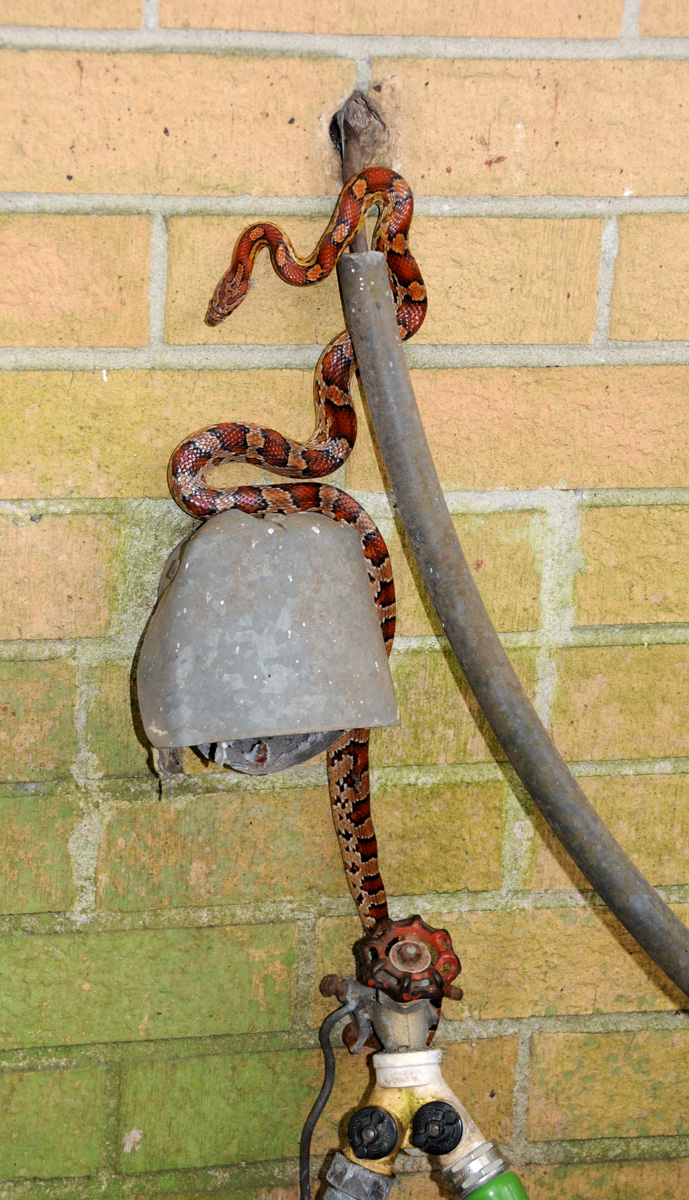
by Rick O'Connor | Apr 24, 2015
This rhyme has been around for decades suggesting that rain increases during the month of April. In recent years the amount we have received has caused local flooding, and most in Escambia County will remember receiving 26” of rain in 24 hours! These heavy localized rain events have certainly removed pollen from the air but they have also dropped blossoms from plants, dropped baby birds from their nests, forced fire ants to surface and move to high ground, and then there are the snakes.
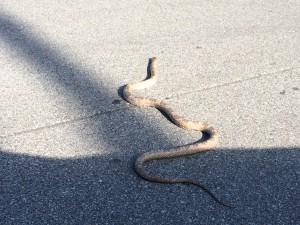
Gray rat snake crossing a driveway.
Photo: Carrie Stevenson
It was actually these flooding events that developed the need for the snake program I am currently doing for Extension. Highly saturated ground forced the snakes to search for high ground. Patios, driveways, garages, and occasionally bathrooms, became popular places for the reptiles to dry off. In the last week or two I have had calls about snakes in buses, on bushes, and in the laundry room, and I actually met someone at a restaurant to identify what kind of snake they found in their home.
For many, it does not matter what kind of snake it is, they are all terrifying and dangerous and unwanted in the yard. For others, nonvenomous snakes are not welcome but they are not life threatening. Venomous snakes on the other hand… well that’s a different story. The problem here is that many do not know how to tell a moccasin from one of the water snakes. When you are not sure, you are more nervous than you may need to be. Venomous snakes truly bother people psychologically.
There are six venomous snakes in Florida and all six have been found in the panhandle. Five of these are members of the “pit viper” group and can be identified by their triangular shaped head, elliptical pupil in the eye, and a heat sensitive pit in front of their nostril. Most venomous snakes also have a dark colored “mask” (stripe) across their face. It is the mask character that I look for first, because many nonvenomous snakes flare their head when threatened and you have to get close to check the shape of their pupil. The pit vipers include the Copperhead, Moccasin, Pygmy Rattlesnake, Timber Rattlesnake, and the Eastern Diamondback. The non-pit viper is the Eastern Coral Snake. Each of these snakes should be considered dangerous and handled only by a professional if in your home. Remember, 95% of the people bitten by venomous snakes are either trying to catch or kill them.
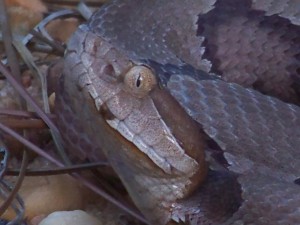
The head of a pit viper. Notice the additional pit, elliptical pupil, and “mask” across the eye. Photo: Molly O’Connor
There are several methods you can use to reduce the chance of an encounter in your yard or home, and Extension would be glad to help with these. But remember, you live in Florida and snakes are part of the landscape here. Also remember there are four snakes in the panhandle that FWC staff are tracking: the Florida Pine Snake, Southern Hognose, Eastern Indigo, and the Eastern Diamondback. If you do encounter any of these visit http://myfwc.com/conservation/you-conserve/wildlife/snakes/ to log a report and include a photograph and GPS location if possible. If you have any questions about snake encounters contact your county Extension office.
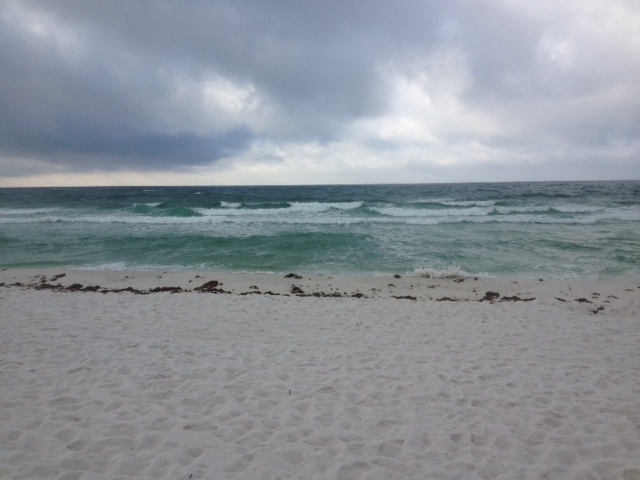
by Rick O'Connor | Apr 17, 2015
As we left the winter months and headed into spring I was expecting a lot of new blooms, new animal tracks, and more live encounters with wildlife… and then the rain began. I do not know if the entire panhandle has been getting what Pensacola has but the rain has been nonstop for over a week now. I track rain days for a water quality project and for the first three months of 2015 the number of days during a month where it rained was between 23-30%. We are about half way through April and so far it has rained 61% of the days. WELL… rain or shine we will make this hike and see what is happening on our barrier island.
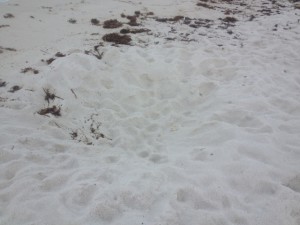
Hole left by a sand castle architect. These can be problems for wildlife and rescue vehicles. Photo: Rick O’Connor
The first thing I noticed when I began the trip along the Gulf was this large hole left by a sand castle architect. These can be problematic for some forms of wildlife, including sea turtles, but they can also be a problem for rescue and turtle watch vehicles. Please enjoy the beach and make awesome sand castles, but when you are finished please fill the hole.
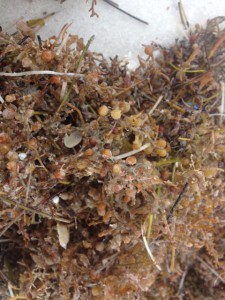
Sargassum is floating form of brown algae. Notice the “air bladders” (pneumatocyst) Photo: Rick O’Connor
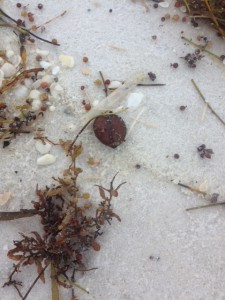
A tropical seed commonly referred to as a sea bean. Photo: Rick O’Connor
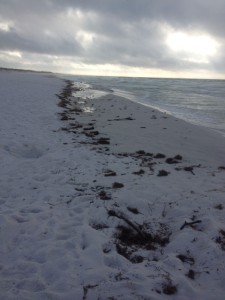
The line of seaweed and debris along the surf zone is called wrack. Photo: Rick O’Connor
The line of seaweed and debris that washes ashore during storms is called the wrack. For the most part it is natural material and provides the nutrients needed for many of the high energy shoreline plants to grow. Many of the beach animals found in the berm and primary dune depend on this wrack as well. Many locals and visitors find this material and eye sore and, at times, producing an unpleasant odor. But this material is an important part of the beach ecology. Sargassum is a drifting member of the brown algae, sometimes called “gulfweed”. It possess small air bladder structures called pneumatocysts that allow it to remain at the surface of the open Gulf where the sunlight is. These large offshore mats of Sargassum have been targets for local fishermen for decades. Many small invertebrates live in these drifting mats and these are targets for small fish, which in turn are targets for even larger sport fish. They are also the hideaway for sea turtle hatchlings. When the little guys head for the Gulf after hatching this is where they are heading. Large ocean currents, including the Gulf Stream, push Sargassum into large mats in the middle of the open ocean. The area within the Atlantic where this happens in known as the Sargasso Sea. If you get a chance this summer, grab a small hand net and mask when the Sargassum is just offshore. Collecting you may find a lot of cool interesting creatures. Sea Beans is a generic word for a variety of tropical seeds that wash ashore in the northern Gulf. Some of these may sprout, including mangroves, but most will not make it through our winters.
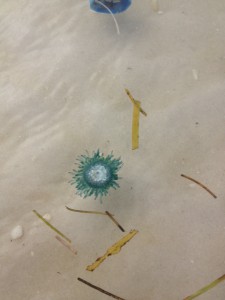
The Blue Button Jellyfish is a tropical cousin of the Portuguese man-of-war. Photo: Rick O’Connor
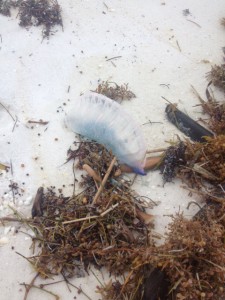
The Portuguese Man-of-War is one of the more venomous jellyfish in Florida waters. Photo: Rick O’Connor.
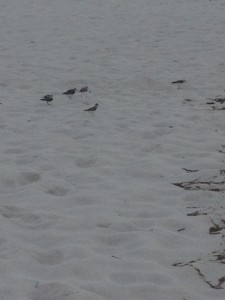
A variety of shorebirds utilize the wrack. Photo: Rick O’Connor
One of the more venomous jellyfish in Florida waters is now making its way onto our shores. The Portuguese man-of-war, named for the many “guns” this animal possess, is well known by locals but not so much by some of our visitors. The man-of-war is actually not one animal but a colony of sedentary polyp jellyfish that produce an inflated bag which floats at the surface carrying them across the sea. The dark blue tentacles hang down into the water column where passing fish are stung and consumed. Each of the polyps have connecting stomachs which helps move the food around to the whole colony. The sting of this jellyfish is quite painful and should be avoided. When they arrive life guards will usually fly a purple flag.
Their close cousins, the Blue Button Jelly, is very similar to the man-of-war albeit they are much smaller and the venom is not as potent. They are more tropical and not common along the northern Gulf but in recent years more have been washing ashore; they are here now.
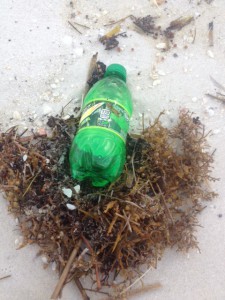
A variety of plastics ends up in the Gulf. Each is a potential problem for marine life. Photo: Rick O’Connor
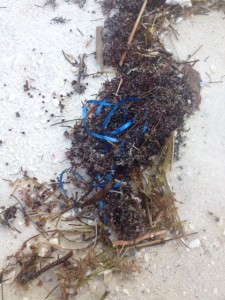
Pieces of plastic ribbon resemble jellyfish tentacles and are frequently consumed by sea turtles. Photo: Rick O’Connor
One of the bigger issues are oceans are facing are discarded plastics. These materials takes years to decompose and are found in all oceans and seas. Even some distant isolated islands have huge piles of this form of marine debris. Plastics can entangle marine organisms or they may actually swallow it, plugging their digestive system and eventually starving them. We encourage locals and visitors alike to help with this problem by taking your trash with you and discarding it in a location where it will not reach the Gulf.
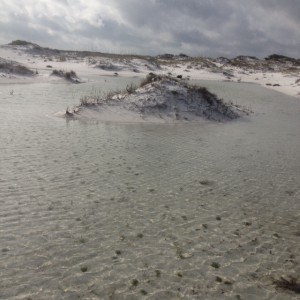
This ephemeral pond formed around a small dune which becomes a temporary island. Photo: Rick O’Connor
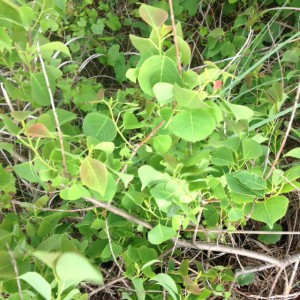
The Chinese tallow is an invasive species the entire state is dealing with. Photo: Rick O’Connor
With the heavy rains of the last week ephemeral ponds have formed on parts of the island. These small pockets of freshwater can be “manna from heaven” for many island residents, particularly the amphibians. I have been hiking this section of Pensacola beach for years, leading field trips for all sorts of groups. I have never seen this Chinese Tallow until today. Also known as the “popcorn tree” due to its unique looking fruit, this plant is listed as an invasive in the state of Florida and is very aggressive. I did not see any others and will seek permission to remove it before it spreads to other dunes and out competes the native plants.
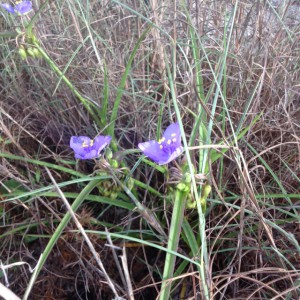
One of the few plants blooming in April, the Spiderwort is a common weed in many lawns. Photo: Rick O’Connor
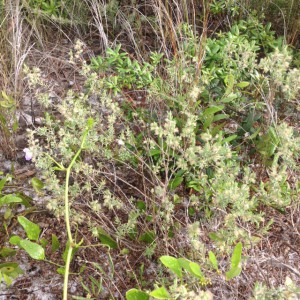
The blossoms of Conradina first appeared in February. They are all but gone this time of year. Photo: Rick O’Connor
I was actually expecting more flowers to be in bloom this month but there were few. The Conradina, which have been in bloom since February, have lost most of its blossoms. The “new kids on the block” are the Spiderwort, the Primrose, the Sandhill Milkweed, and the Devil’s Joint Cactus.
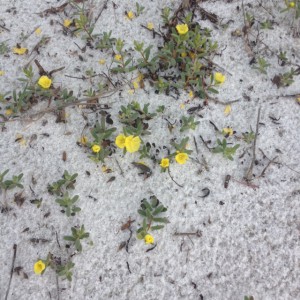
There are a variety of primrose that grow on our barrier islands. They are beginning to bloom now. Photo: Rick O’Connor
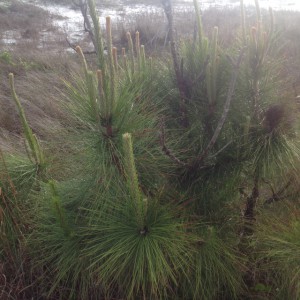
New growth on a pine tree. Photo: Rick O’Connor
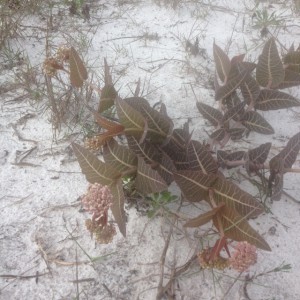
The Sandhill Milkweed. Photo: Rick O’Connor
The Sandhill Milkweed is one of the plants used by the monarch butterfly to gain fuel for their great flight across the Gulf to Mexico. The milky toxic sap of this plant is consumed by the monarch caterpillar but it does not harm it. The chemical toxins therefore become a defense for the monarch and the butterfly has earned the respect of many birds; though it may be a trial and error learning experience.
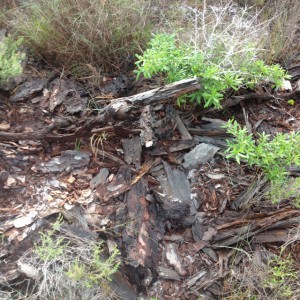
A decomposing log is a microhabitat for many organisms. Photo: Rick O’Connor
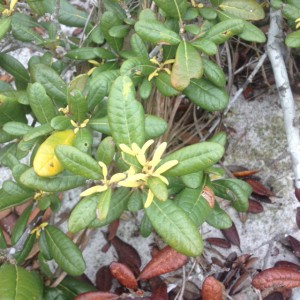
New growth on a live oak. Photo: Rick O’Connor
Most environmental centers, state and federal parks, leave fallen trees where they lie. The tree is actually a storage house of nutrients and full of cavities that can be used by a lot of organisms within the beach community.
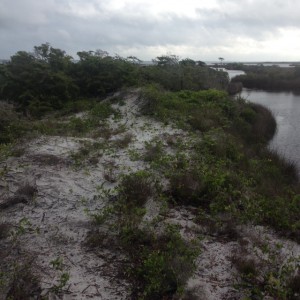
The mysterious “drags” we have seen the last three months were not to be found in April. Photo: Rick O’Connor.
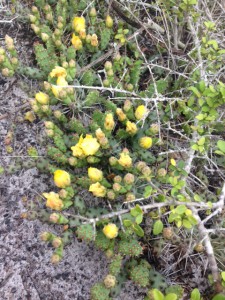
The beautiful yellow bloom of the Devil-Joint cactus. Photo: Rick O’Connor
This month the weather was warm enough for me to venture into the Salt Marsh. Salt marshes are wetlands but differ from swamps in that the dominate plants are grasses, not trees. Our local salt marsh is dominated by two species of grass, the Smooth Cordgrass, and the Black Needlerush. There are many other plants that exist here but these are the most common. This particular marsh is dominated by Black Needlerush. Salt marshes are one of the most productive systems on the planet, producing tons of organic material annually. 90% of the commercially valuable marine species spend part or all of their lives here. There are many unique species to this system as well. Today the water was crystal clear but I saw few fish. I expect as it gets warmer we will see more. It is very possible that with the heavy rains that they have moved to deeper, saltier spots in the Sound.
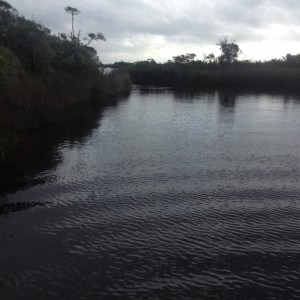
It’s warm enough to enter the salt marsh. Photo: Rick O’Connor
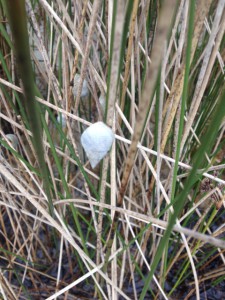
The marsh periwinkle is one of the more common mollusk found in our salt marsh. Photo: Rick O’Connor
The Marsh Periwinkle is an interesting guy. This snail will crawl up the stalks of marsh plants during high tide to avoid predators like blue crab and diamondback terrapins. Both of these predators appear to be on the decline and it will be interesting to see how this impacts the ecology of the marsh. At low tide the periwinkles descend and feed on the organic leaf litter on the muddy bottom.
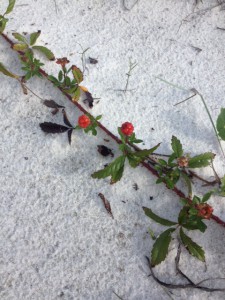
This dewberry has flowered and the dark fruit will be ready next month. Photo: Rick O’Connor
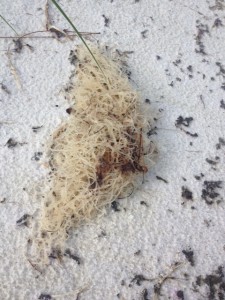
Gracilaria is a common epiphytic red algae growing in our seagrass beds. Photo: Rick O’Connor
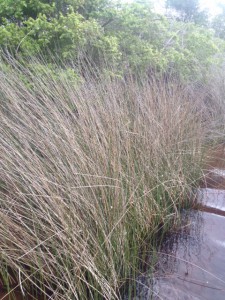
Black Needlerush is one of the two dominant plants of our salt marshes. Photo: Rick O’Connor
Though it has a white appearance, Gracilaria is a member of the red algae group. This algae grows on seagrasses as Spanish moss grows on oaks. The plant is usually kept in check by herbivorous grazers, such as green sea turtles, but in recent decades the number of predators have declined and the amount of nutrient runoff has increased. This has sparked a increase in the growth of this algae and, in some cases, to the determent of the seagrass itself.
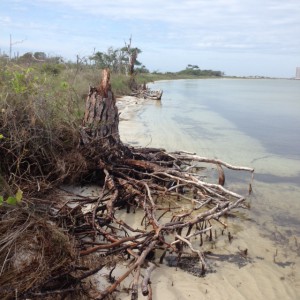
This eroded pine tree gives evidence of the ever changing shorelines of our barrier islands. Photo: Rick O’Connor
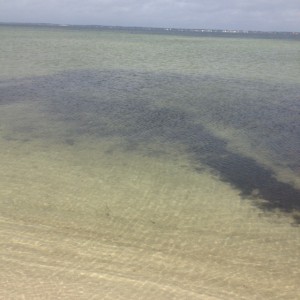
This submerged mound of peat is the remnants of a salt marsh which is now below sea level. Photo: Rick O’Connor
These photos of peat and the eroded tree are indications of a changing shoreline. Due to storms, boat wake, and time, the shoreline of Santa Rosa Island, like all barrier islands, is changing. Peat is actually the remnants of an old salt marsh that has now pass the high tide line and is within the Sound.
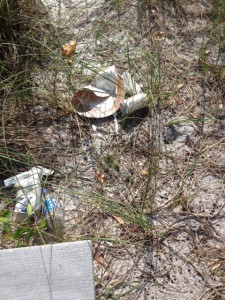
Trash left behind by those enjoying the beach. Photo: Rick O’Connor
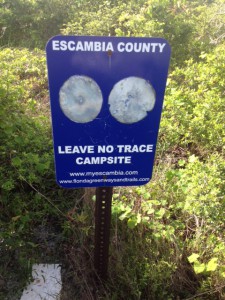
We encourage those who pack it in… to pack it out. Photo: Rick O’Connor
As the weather has warmed and spring break has fallen upon us I have noticed an increase in the amount of trash on this hike, both the Gulf of Sound sides. We encourage locals to take their trash with them and encourage visitors to do the same. Let’s try to keep our waste out of our waters.
I am expecting some animal nesting in May. We will see what we find. Until then.

by Rick O'Connor | Apr 10, 2015
The American Alligator is an icon in the state of Florida. Viewed on the program “Swamp People” and as the mascot of the University of Florida, most visitors to our state view this animal more on television than in the wild; but they are certainly there. In need of mates and calories from the lack of eating over the winter, alligators and other reptiles become more active this time of year. Visitors and residents alike should be a little more cautious.
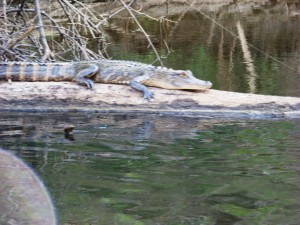
Alligator basking on the Escambia River; photo: Molly O’Connor
Like most predators, alligators seek food that will provide them energy. Generally predators will target prey that will cost them very little energy to capture and kill. Obviously small alligators will feed on small prey but adult alligators feed on smaller prey than many think. Fish, turtles, snakes, small mammals and birds make up the bulk of their diet. If the opportunity presents itself, and they do not have to expend too much energy, alligators will certainly take larger mammals and birds.
For humans the bigger problem has been the loss of pets and livestock. Small dogs are certainly easier prey than a human, and with the loss of habitat encounters with humans and their pets have increased. Since 1948 FWC has estimated about 300 alligator attacks on humans directly, less than 10% of these were fatal. As more alligators are forced into suburban areas more encounters have occurred. In the last 10 years 16,000 nuisance alligator calls have been reported to the FWC. As with other wildlife, like coyotes, many of these animals are living in ditches and other watering holes where they seek fish and turtles. However if we visit such places, particularly with our pets, these animals may certainly make an attempt to grab them. If you feel an alligator is a nuisance and could be a potential problem you can call FWC at (866) FWC-GATOR; (866) 392-4286). Folks should be aware that FWC does not relocate nuisance alligators, they will be destroyed. Currently FWC issues about 7000 permits for alligator control across the state.
A couple of safety notes if you live near waterways with alligators.
- Do not swim in these locations at night; alligators are more active hunters between dusk and dawn
- Try to discard fish remains after cleaning in another location besides the water; if these locations have a few alligators they will certainly learn this habitat and hang around the boat ramp more.
- DO NOT FEED alligators; help us let visiting tourists know this and that it is illegal in our state. Alligators fed by humans will eventually lose their natural fear of us and this could bring on problems.
These are awesome animals. We should better understand their natural history so that we can exist with them. For more information on alligators in your area contact your county extension office.
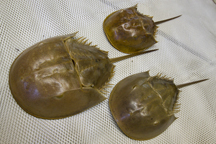
by Rick O'Connor | Apr 10, 2015
These curious ancient animals have been roaming the waters of the Atlantic and Gulf of Mexico for over 450 million years. Though they appear dangerous they are quite harmless and are actually more closely related to spiders and scorpions than crabs. Horseshoe crabs are not as common in Pensacola as they are in Panama City and Port St. Joe areas, but once were once found here and occasionally still are. Many coastal states have been concerned by the decline in their numbers. In the Chesapeake area where they were once very common, horseshoe crabs are harvested for their copper-based blood and also as bait for eel fishermen. The copper-based blood contains lysate which has been used to detect bacterial contamination in many drugs, as well as use for the diagnosis for some diseases.

The ancient horseshoe crab. Photo UF/IFAS Communications
Though there is a fishery for them in Florida, the issue with most locals is just the loss of a really neat animal that has been around longer than the dinosaurs,. This time of year, near the full moon, horseshoe crabs begin to gather near nesting beaches to mate and lay eggs. The Florida Fish and Wildlife Conservation Commission is asking locals and tourists who find a horseshoe crab to report it. They are interested in sightings of both adults and juveniles (less than 4” in length), the date seen, the time, the location, and type of habitat if possible. To report you can visit their website (www.MyFWC.com), email at FWRI@horseshoe@fwc.state.fl.us , or call 1-866-252-9326
If you have any questions contact your county Sea Grant Agent for more information.

![Life Stages of the True Jellyfish: Photo: By Matthias Jacob Schleiden (1804-1881) [Public domain], via Wikimedia Commons](https://nwdistrict.ifas.ufl.edu/nat/files/2015/05/Schleiden-meduse-2-202x300.jpg)






































